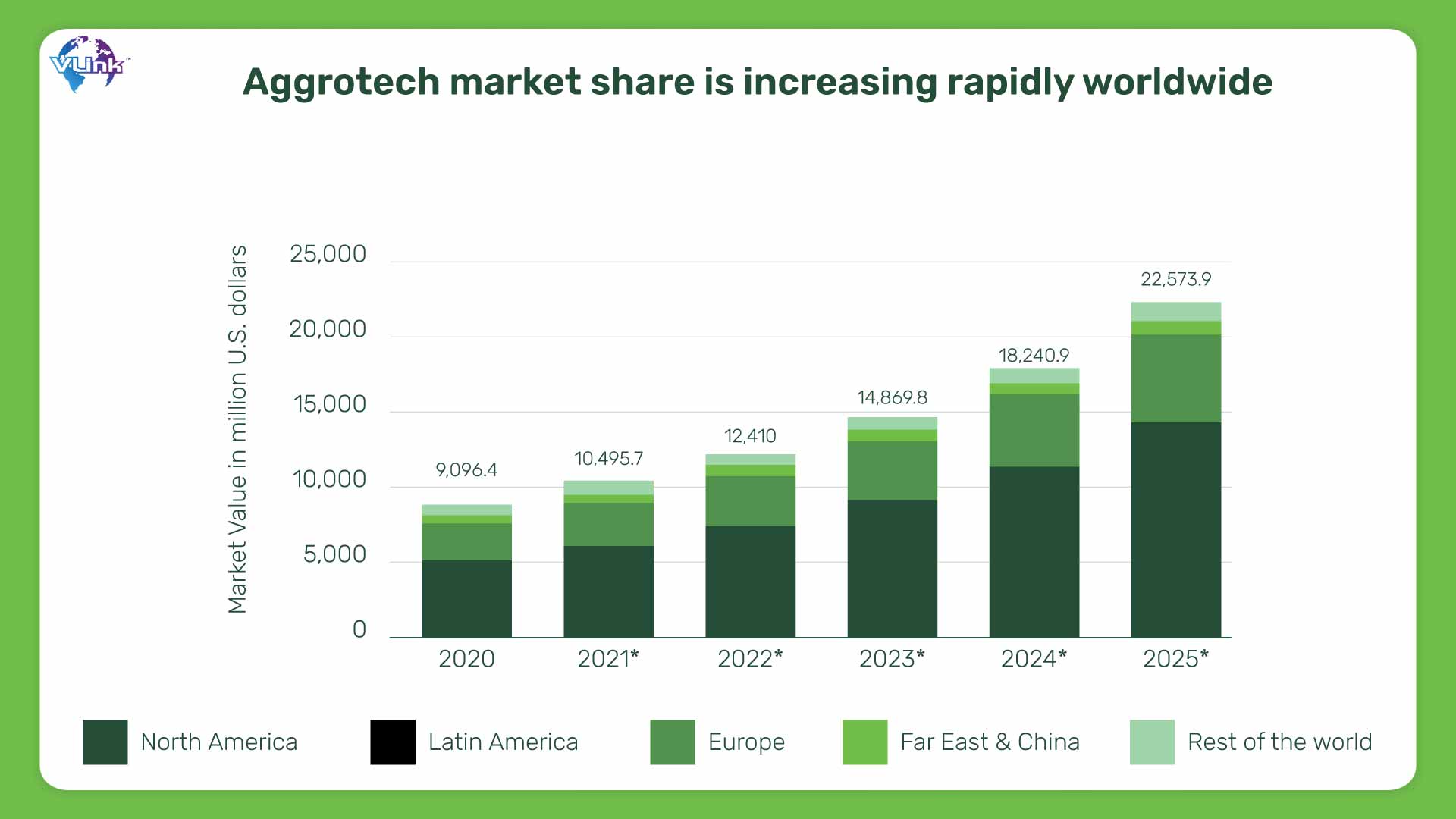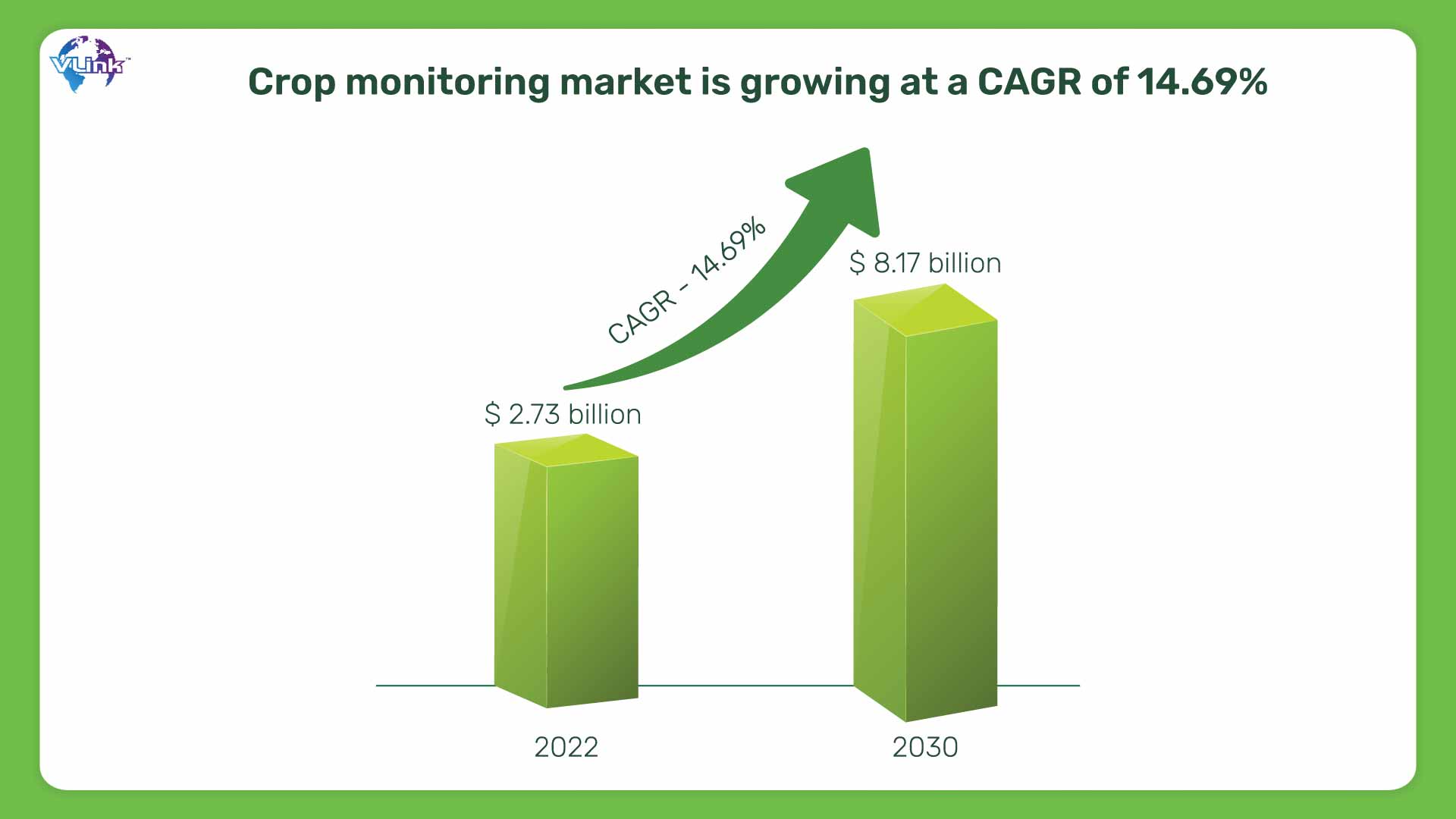Farming is one such activity that has been around since the beginning of time. It has undergone significant renovation during the previous century, particularly in the last several decades. Farming is no longer regarded as conservative or conventional.
Modern farming is technologically advanced and inventive. A few decades ago, it would have been difficult to imagine the relationship between mobile technology and farming, but it is now a reality. Many Mobile-Agri apps are being developed these days, which will have a good influence on the lives of millions of farmers. A significant amount of research is necessary to design such an app.
Farmers are already embracing new and developing technology to expand their operations. Furthermore, according to Zion research, the worldwide smart agricultural industry will expand from $5 billion in 2017 to more than $15 billion in 2025.

Furthermore, the need for an expert mobile app development business is growing as they give farmers an easy method to manage their fields via strong agriculture applications. Farmers may use these applications to get information about crop and soil health, weather forecasts, and insect control.
Types of agriculture apps
From seeding crops to selling them to end consumers, technology has penetrated almost every facet of agricultural operations. Here are several farming applications that may assist farmers in growing crops, caring for them, calculating environmental effect, and monitoring other areas of their agricultural company, such as animals.
Weather has a significant impact on agricultural productivity, and weather forecast applications may assist farmers in planning planting, irrigation, and harvesting schedules.
These applications give farmers temperature, rainfall, humidity, and wind speed information based on real-time meteorological data and predictions. The Weather Channel, Weather Underground, and AccuWeather are three popular weather forecast applications for farmers.
Cattle management applications are particularly intended for cattle ranchers. Farmers may use these applications to assess herd health and production, control breeding schedules, and monitor feed and water use.
Apps for farm planning and mapping are two of the most popular agricultural technology solutions. Farmers may use them to monitor and assess crop development, care for animals, and forecast to avoid bad weather situations.
Farmers use GPS tracking applications to track the position of farm equipment and vehicles. These apps employ GPS technology to deliver real-time position and movement information on tractors, combines, and other agricultural equipment, allowing farmers to improve their operations and save downtime.
![]()
Farmers may use grain elevator applications to manage their grain inventories and watch pricing in real time. These apps allow farmers to check current market prices, handle contracts, and follow grain elevator delivery.
Must-have features in agriculture app development
Mobile agriculture has successfully expanded into previously unexplored areas. Agricultural app development is now supporting many farmers and agriculture-based businesses in extending and boosting their production to reach a broader market.
Have a look at some features that should be included while building an agriculture app.
It's difficult to conceive farming software without a map. Farmers may utilize mapping to access a variety of location-based capabilities, such as following drone investigations and seeing local weather predictions.
A location-based service may also assist in dividing a field into polygons so that each one can be investigated independently and pin places that require special attention. Farmers may use maps to find specialty crops, pesticide applicators, and other resources.
Forecasting is an important part in developing agricultural apps. Farmers who possess apps with these characteristics will be able to predict the weather and crop viability far further in advance, allowing them to take the required safeguards to protect their crops.
Some applications function as markets for agricultural products such as insecticides, seeds, and machinery. Farmers may discover the best bargains by using agricultural marketplaces, which connect customers, dealers, and producers. Each listing in a marketplace app includes a photo and description of the goods, as well as delivery times, and so on.
Some agriculture apps are based on visual data and machine learning, allowing farmers to detect plant illnesses at an early stage, identify weeds, monitor nitrogen levels, and assess leaf damage. There are several open-source libraries for machine vision; get advice from skilled developers to select the best one for you.
Also Read: How Much Does It Cost to Build an iOS App
Any mobile application must have push notifications. They assist farmers in keeping track of many tasks that require their attention, alerting them to changes, crises, and new data, and reminding them of calendar events. Rich push notifications, which include images and even maps, may be used to provide even more information in your reminders.
A crop timetable function in an agricultural application helps farmers to organize and manage crop cultivation, planting, and harvesting activities. This tool may give farmers a thorough picture of their crop cycle, including planting, fertilizing, and harvesting dates, as well as any other key crop management chores.

Additionally, the functionality can offer farmers notifications and reminders for duties such as spraying pesticides or fertilizers, assisting them in completing these operations on time.
Any ecommerce mobile app, particularly agricultural mobile applications, need a safe and trustworthy payment gateway. Farmers may use the payment gateway option to perform safe transactions within the app to purchase necessary commodities such as insecticides, seeds, and other agricultural equipment.
The payment gateway capability may be enabled by connecting with well-known payment processors such as PayPal, Stripe, or Square. This connection can give credit/debit cards, internet banking, and e-wallets as payment choices for the app.
One of the most crucial elements of the mobile agricultural app is drone integration. Farmers may use drones to inspect the condition of their crops and make strategic decisions to increase their quality.
Farmers may use drones to spray pesticides, gather soil samples, and detect water leakage using infrared cameras attached to the drones. However, drones are subject to various regulatory regulations, such as the requirement that they only fly during the day and be always visible to the pilots.
Steps to create an agriculture app
Developing crop farming software needs careful consideration throughout the whole development process. Because each stage is important, we have combined them all in one place and disclosed farm app development advice.
Creating an agribusiness mobile app is a time-consuming process that requires careful preparation. So, consider some critical phases in developing a responsive mobile app for your agri-business.
1- Ideation & project evaluation
A small team managed by the project manager is required to kick off your project. To establish a well-documented project plan, the team should include a software architect and a few business analysts. Business analysts should collect and assess the functional requirements that your app must meet.
Ideation is the first phase in designing agriculture apps, in which you seek solutions to a variety of challenges. The questions may be about how you want your agriculture applications to help farmers, as well as the region, nation, or area you want to target.
2- Business & tech specs analysis
A business analyst is a technical practitioner who can discover the best technological solution to a real-world situation. Typically, the business analyst's work results in a technical specification: a codified document that covers all specifics about the development process, such as features, timelines, pricing, team members, and so on.
A technical specification gives guidelines for developers while also assuring the client that they will receive exactly what they anticipate. This phase is required if you want to construct an agriculture app: it will help you design a farm app, control the process, and test your product.
3- Make a project plan
It is your responsibility to build an excellent project strategy to assure the success of your agriculture app. Include the MVP and its future tasks, dependencies, timeline, and budget in your project plan. Furthermore, examine the following metrics: quality standards, risk management, communication management, human resource management, stakeholder management, and so on.
4- Pre-development phase
In the following step, agriculture app developers are needed to describe the relevant back-end APIs, third-party services, cloud storage, and other app architecture-based components of the development process.
Designers, on the other hand, begin by generating wireframes and then prototypes before designing features, visuals, controls, and so on. At this stage, developers should proceed with caution and focus on building a scalable foundation that can be modified as needed in the future.
5- Building & testing the agriculture app
Native, cross-platform, and hybrid app development necessitate the use of several technologies and tools. The app specification sheet you created before acts as a baseline, ensuring that nothing is missed throughout development.
Meanwhile, the testing step is continued by the quality assurance crew once each module is produced by the programmers. This type of testing assists app development by allowing for simultaneous testing and dealing with complexities.
6- Launching & deploying the app
This is the moment when the rest of the world discovers your app. Once your developers have ensured that the app fulfills all app store criteria, you will be able to launch it and begin collecting data.
The technique you use to acquire users will be determined by your target market. Traditional marketing and highly focused digital marketing are the greatest ways to advertise your application directly to farmers.
7- Post-launch support
Developing agricultural applications does not end with deployment. No application can exist unless it is constantly maintained. New technologies and frameworks arise as the world transitions to new operating systems, your app must evolve.
During the maintenance phase, you may also upgrade and develop new features, as well as make minor adjustments to your project. This will guarantee that your software remains relevant and provides the most value to your consumers.
Choosing the right tech stack for agriculture app development
Creating an agriculture app using a variety of tools and technologies may ensure that it is dependable and scalable. Having a basic understanding of the mobile app development tech stack will allow you to contribute your viewpoint to the decision-making process. The following are some of the technological stacks needed to develop an agriculture app.
- The programming languages used to create the application include Java, Kotlin, Swift, and Objective-C.
- React Native, Flutter, and Ionic Node are three mobile app development frameworks. Backend technologies for developing smart agricultural apps include JavaScript, Ruby on Rails, and Django.
- Cloud hosting services include Amazon Web Services (AWS), Google Cloud Platform (GCP), and Microsoft Azure.
- Databases include MySQL, PostgreSQL, and MongoDB.
- OpenWeather API, Google Maps API, and Twilio API are examples of APIs.
- Integration of GPS, IoT, and Bluetooth sensors.
Creating an agricultural mobile application necessitates the use of both frontend and backend programming languages, as well as the relevant databases and APIs. It is critical to choose the proper firm to assist you in selecting the optimum technology mix.
How can VLink help with agriculture app development
There are several agricultural applications available to help farmers work smarter and get better outcomes with less effort. Though mobile software is utilized in a variety of ways in agriculture, there are several instances when agricultural app development looks to be especially beneficial.
VLink provides a tried-and-true solution to satisfy the unique requirements of your company. Our team of professional developers will work on your project to provide you with a digital platform for earning cash from farmers and clients in the agriculture business.
We employ cutting-edge technology and best practices to make your software safe, scalable, and user-friendly. Using our experience in bespoke app development, we can create a digital platform that enhances productivity and efficiency in agricultural operations, allowing you to make more cash from your clients.








 Shivisha Patel
Shivisha Patel
















